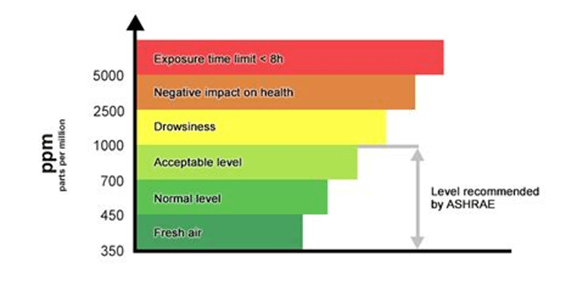The Canadian province of Quebec recently mandated that to improve air quality indoors, every classroom would have CO2 detection by 2022. The problems that are addressed within classrooms or any occupied indoor space include the need to predict higher probabilities of airborne illnesses and the need to detect high CO2 levels that impair attention. (Quebec to install CO2 detectors in all classrooms by the end of the 2022 school year: letter)

The studies on high CO2 levels are well defined and accepted with specific guidance on various concentrations. Creating CO2 sensor modules and systems with high performance and reliability has several key considerations. There are single and dual NDIR (Nondispersive infrared) modules. The single module systems have one optical path and are generally less expensive. The cost tradeoff is in calibration and accuracy as the modules with two optical paths can use one path for compensation, ensuring long life and higher performance.
In designing the CO2 module, a thermopile detector is chosen. These detectors will have filters or coatings that only allow specific wavelengths of infrared light (see Figure 1). The Renesas RTD120D thermopile is one such thermopile detector. It is a two-channel silicon-based thermopile detector that offers a low-cost solution with high output. Each small active area is 1.2mm x 1.2mm. It responds quickly to intensity changes with a time constant of 25ms, and its Nitrogen encapsulation gas allows stable performance and long lifetime.

Figure 1. Dual channel thermopile gas detector
The other key attributes of a CO2 module are in the emitter and the construction of the module light path. Renesas offers an evaluation kit for the RTD120D that provides an appropriately selected infrared light source with a long light path to maximize the sensitivity to the changes in CO2 concentration, thus providing excellent performance. The kit provides all the system components and firmware needed to realize a complete CO2 detector solution with PC connectivity for analysis of the raw thermopile readings and data at various stages of the processed signal flow. This allows designers of CO2 detection systems to start with a working design that can be studied and adapted to suit specific requirements.
Once we have a reliable CO2 detector, a number of system-level features can be considered in a solution. Specifically, the measured CO2 concentration can be relied upon for notifying people of potentially harmful levels, beyond the acceptable levels of 350 to 1000 ppm (see Figure 2 below), automatically adjusting the HVAC system to bring the ambient level back toward normal conditions.

Figure 2. CO2 concentration levels
Also, the stream of CO2 concentration data can be used in cloud-based applications to learn and modify occupancy plans and/or HVAC system capacities. These factors can provide confidence to the parents of those children in Quebec school systems, knowing that high CO2 levels are not limiting their children from learning and possibly impacting their health.
